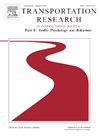Social cognition and driving: Theory of mind is associated with drivers’ hazard perception
IF 3.5
2区 工程技术
Q1 PSYCHOLOGY, APPLIED
Transportation Research Part F-Traffic Psychology and Behaviour
Pub Date : 2025-06-19
DOI:10.1016/j.trf.2025.06.017
引用次数: 0
Abstract
For many, driving enables participation in different aspects of life. However, crashes can incur substantial personal and economic burdens. There has been ample research documenting the cognitive factors that predict crash risk (e.g., attention). However, a large part of driving involves interaction with other road users. This means that social-cognitive factors may also be implicated in crash risk. Here, in a sample of N = 120 young adult drivers, we measured important aspects of driver skill (hazard perception) and driving style (following distance), which predict crash risk, and tested their association with two novel social-cognitive variables: (1) theory of mind (for hazard perception), and (2) empathic concern (for following distance). Empathic concern was not associated with following distance. However, individuals’ theory of mind was associated with their hazard perception skill performance. This highlights that social-cognitive factors can be associated with crash risk and demonstrates the potentially far-reaching consequences of drivers’ theory of mind for road-user safety.
社会认知与驾驶:心理理论与驾驶员危险感知相关
对许多人来说,驾驶使他们能够参与生活的各个方面。然而,坠机会带来巨大的个人和经济负担。有大量的研究记录了预测撞车风险的认知因素(例如,注意力)。然而,驾驶的很大一部分涉及与其他道路使用者的互动。这意味着社会认知因素也可能与撞车风险有关。在这里,在一个N = 120的年轻成年司机的样本中,我们测量了预测碰撞风险的司机技能(危险感知)和驾驶风格(跟随距离)的重要方面,并测试了它们与两个新的社会认知变量的关联:(1)心理理论(危险感知)和(2)共情关注(跟随距离)。移情关注与跟随距离无关。然而,个体的心理理论与他们的危险感知技能表现有关。这突出了社会认知因素可能与碰撞风险有关,并证明了驾驶员的心理理论对道路使用者安全的潜在深远影响。
本文章由计算机程序翻译,如有差异,请以英文原文为准。
求助全文
约1分钟内获得全文
求助全文
来源期刊
CiteScore
7.60
自引率
14.60%
发文量
239
审稿时长
71 days
期刊介绍:
Transportation Research Part F: Traffic Psychology and Behaviour focuses on the behavioural and psychological aspects of traffic and transport. The aim of the journal is to enhance theory development, improve the quality of empirical studies and to stimulate the application of research findings in practice. TRF provides a focus and a means of communication for the considerable amount of research activities that are now being carried out in this field. The journal provides a forum for transportation researchers, psychologists, ergonomists, engineers and policy-makers with an interest in traffic and transport psychology.

 求助内容:
求助内容: 应助结果提醒方式:
应助结果提醒方式:


